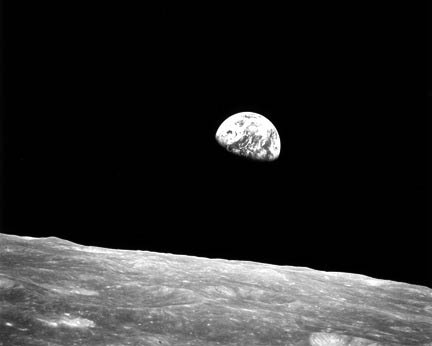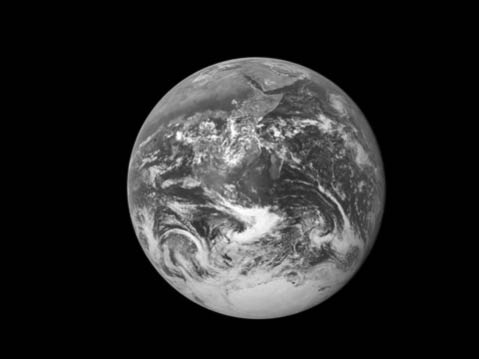Chapter 1
By Eugene F. Provenzo, Jr. and Cory A. Buxton
Earth’s Drinkable Water

| Florida Sunshine State Standards Benchmark | |
| SC.A. 1.2.1 | The properties of materials (in this case, volume) can be compared and measured. |
|---|---|
| SC.D. 1.2.2 | 70 percent of the surface of the Earth is covered by water. |
| SC.D. 2.2.1 | Reducing, reusing, and recycling natural resources improves and protects the quality of life |
Water, Water, Everywhere: But Hardly a Drop to Drink

Apollo 17 photograph of the Earth.
Courtesy of the National Aeronautics and Space Administration
Water is found nearly everywhere on Earth. It is found in the air, on land, and in all living things. It is also found in oceans, lakes, rivers, streams, and ponds. Approximately 75% of the Earth’s surface is covered by water. Much of Florida’s water is found in marshes, swamps, and wetlands. One of the major wetlands in Florida is the Everglades. An abundant supply of water can also be found below the ground in the form of groundwater. Most people in the United States get their drinking water from groundwater. On average, Florida receives about 54 inches of rain per year. Where does all that water go?
That is a lot of water. When astronauts look down on the Earth from space, they see a planet that is mostly water. You can get a sense of how much of the Earth is covered with water by using an apple as a model for the Earth.
Activity: The Earth as an Apple

In the following activity, you will learn about the different parts that make up the Earth. You will use an apple as a model of the Earth and will cut the apple into slices to represent the oceans, mountains, farmlands, and other parts of our planet.
Materials Needed:
- A whole apple
- A plastic knife
- Paper towels
To make your model of the Earth as an apple, follow the steps below:
- Using the plastic knife,slice your apple into four equal quarters. Set aside three of the quarters. These three quarters represent the oceans of the world. The fourth quarter of the apple represents the total land area left.
- Slice this land quarter in half, giving you two 1/8 pieces. Set aside one piece. This piece represents land where it is very hard for people to live (polar areas, deserts, swamps, very high or rocky, mountainous areas). The other 1/8 piece represents the land where people live on Earth.
- Slice this 1/8 piece of the apple into four sections, giving you four 1/32 pieces. Set aside three of these pieces. These three pieces represent area that are too rocky, too wet, too cold, too steep, or with soil too poor to produce food. These pieces also include land that could produce food but is buried under cities, highways, suburban developments, shopping centers, and other structures that people have built.
When we see the small amount of land that produces our food, it is easy to understand that protecting land resources is very important. With a fixed amount of land resources available, and an ever-increasing number of people who need to eat, each person’s portion becomes smaller and smaller over time.
What about the water? How much of the apple represented water? It probably seems like a lot of water, and it is. You need to remember two things, however, about this water. First, Earth’s water is composed of 97% salt water, 2% ice, and only 1% groundwater and surface water (lakes, rivers). Only the last two sources (groundwater and surface water) provide our useable water. Second, the water we have on Earth today is all the water we’ll ever have. Every use of water also pollutes it. We need to clean up polluted water in order to make it safe for consumption. We will not get any more, so we need to protect the water we have.
Have students review the following summary questions:
- Why do you think the Earth is sometimes called a water planet?
- When we used an apple as a model for the Earth, what did the skin of the apple represent?
All of us need to be concerned with how scarce useable water is on the Earth. Even those of us who live in places where water seems plentiful have an obligation not to waste water. In the following activities, students should become more aware of water conservation issues and how they can contribute to protecting this precious resource.
Exploring One Water
How is the perception of water different for people living in Rajasthan, India where fresh and drinkable water is scarce compared to a place like Florida where water is abundant?
East Indians Gathering Water
Watch the clip from One Water. How would your life, and the life of your family, be different if water was as scarce for you as for the people shown in the film?
How would your day-to-day life be affected?
Would there be things that you would gain from water being scarcer for you and your family?
Consider the Quote
“When drinking water think about its source.” — Anonymous
Extension Activities
Elementary School Students
Create a list with students of the different ways water is part of their lives. Discuss with them which uses are essential to living and which are recreational or a luxury. For example, is a long shower necessary? Ask them to consider what it would be like to have a day without any access to water.
Multimedia
Have students draw a visual map of their house that shows all the places where water is used.
Middle School Students
Have students work in teams to compile a list of twenty-five ways that water can be saved in their households (use water restricting showerheads; when washing dishes, use a sink full of water, do not let the water run; fix leaky faucets - a steady drip can waste 20 gallons of water per day, and so on .)
Multimedia
Using a digital camera, have students photograph places in their houses where water is being wasted . Have them create Power PointTM presentations or posters that document what they have discovered . A bulletin board display can be created incorporating materials from different students
Secondary School Students
Estimates are that the average American uses 80-100 gallons of fresh water per day . Have students do research on the Internet to find out what constitutes the largest personal use of water (flushing toilets followed by showers) . Have students determine how much water is saved by using water- efficient toilets (most new toilets use half the water of toilets manufactured twenty years ago - some only a quarter) . Have students determine how much water is used if everyone in the state used older toilets versus newer and more efficient systems (assume that people use the toilet on average five times per day) . Determine how much water could be saved by the state in one day if we all switched to water-efficient toilets.
Multimedia
Have students create a film for YouTube or some other public site documenting how we waste water in showers and toilets and what we can do to decrease this water wastefullness.
